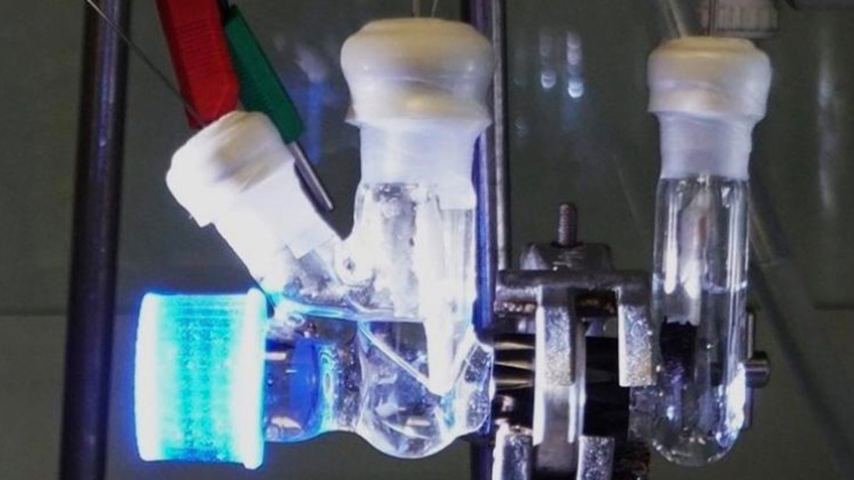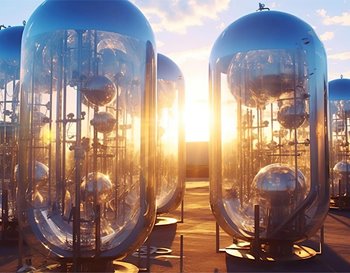Using the Sun to Capture Carbon and Address Plastic Pollution
Using the Sun to Capture Carbon and Address Plastic Pollution


University of Cambridge researchers have developed a new carbon capture and utilization technology powered by the sun.
Over the past few years, scientists have been diligently working to develop novel carbon capture and storage technologies to help industrial organizations better meet their environmental and sustainability goals. Such solutions capture carbon dioxide from the air and then pump it underground for storage.
While this can help reduce greenhouse gases in the atmosphere, Motiar Rahaman, a researcher in Erwin Reisner’s laboratory at the University of Cambridge’s Yusuf Hamied Department of Chemistry, said such solutions require electricity—and the long-term effects of storing excess carbon underground is not known.
“Current CO2 concentration in the atmosphere is rising day by day and we need to mitigate this to stop global warming. It can take a lot of energy to do this, and we don’t really know what happens when it is stored in the ground or rock bed for a decade or longer,” he said.
“At the same time, we also see there is a huge problem with plastic pollution. It’s already covering a huge amount of landfill and seabed. We wanted to find a way to better address this excess CO2 concentration, the energy crisis, and plastic pollution at the same time through an integrated electrochemical system.”
Become a Member: How to Join ASME
Reisner’s group has been developing net-zero carbon fuels using a unique photosynthesis technology for several years. This innovative system can take CO2, filter it through artificial leaves, and then convert it to syngas, a precursor to sustainable fossil fuel alternatives. Reisner said sunlight is a completely clean energy input, unlike electricity, and could help make it easier for industrial players to get to net-zero.
“We can operate this kind of system without being connected to the electricity grid, which means these technologies could be used in a decentralized off-grid scenario,” he said. “That would be especially beneficial in developing countries where there are challenges for fossil fuel-free infrastructures to emerge.”
Sayan Kar, another researcher in the Reisner lab, said there is currently a lot of attention on carbon capture processes, especially from the air or from industrial exhaust. But the use of electricity to power such technologies means that fossil fuels may still be involved. To better meet net-zero carbon goals, he said, researchers must think beyond capture and find ways to actually use CO2 emissions.
“If we can capture CO2 directly from the atmosphere and make something useful out of it, then we have a better chance of getting away from fossil fuels altogether,” Kar said.
To that end, Rahman, Reisner, and Kar leveraged their existing photosynthesis technology to develop a solar-powered reactor that can capture CO2 directly from the air and convert it to syngas using plastic waste. This unique system has the additional benefit of transforming plastic waste into glycolic acid, a crystalline solid ingredient that the cosmetic and skin care industry currently uses. Rahaman said the chemistry was quite “tricky,” but they are proud to have created a system that can tackle two pressing environmental problems at the same time.
The plastic waste, surprisingly, plays a critical role in the CO2-to-syngas conversion. Rahaman said plastic, as it breaks down, provides vital electrons to the CO2, which makes the transformation possible.
“This is the first example of solar-driven conversion of CO2 captured from the air and we’ve coupled it with plastic oxidation,” he said. “Being able to transform plastic into glycolic acid not only makes the entire process more thermodynamically feasible. It also addresses another big problem that is affecting our environment.”
The researchers envision that manufacturers or other industrial companies could one day use this kind of system to capture and utilize CO2 emissions to make sustainable fuels, while also creating useful byproducts for other industries. But the proof-of-concept system will take considerable time and effort to scale up for real-world industrial applications.
“We need to focus on increasing the efficiency of the system. We can take CO2 directly from the air and convert it to syngas, but the efficiencies are still quite low. We are working on that now,” Rahman said. “It will probably take a decade for us to optimize everything before we can think about scaling it up for industrial use.”
Kayt Sukel is a technology writer and author in Houston.
While this can help reduce greenhouse gases in the atmosphere, Motiar Rahaman, a researcher in Erwin Reisner’s laboratory at the University of Cambridge’s Yusuf Hamied Department of Chemistry, said such solutions require electricity—and the long-term effects of storing excess carbon underground is not known.
CO2 and plastics
“Current CO2 concentration in the atmosphere is rising day by day and we need to mitigate this to stop global warming. It can take a lot of energy to do this, and we don’t really know what happens when it is stored in the ground or rock bed for a decade or longer,” he said.
“At the same time, we also see there is a huge problem with plastic pollution. It’s already covering a huge amount of landfill and seabed. We wanted to find a way to better address this excess CO2 concentration, the energy crisis, and plastic pollution at the same time through an integrated electrochemical system.”
Become a Member: How to Join ASME
Reisner’s group has been developing net-zero carbon fuels using a unique photosynthesis technology for several years. This innovative system can take CO2, filter it through artificial leaves, and then convert it to syngas, a precursor to sustainable fossil fuel alternatives. Reisner said sunlight is a completely clean energy input, unlike electricity, and could help make it easier for industrial players to get to net-zero.
“We can operate this kind of system without being connected to the electricity grid, which means these technologies could be used in a decentralized off-grid scenario,” he said. “That would be especially beneficial in developing countries where there are challenges for fossil fuel-free infrastructures to emerge.”
Eliminating fossil fuels
Sayan Kar, another researcher in the Reisner lab, said there is currently a lot of attention on carbon capture processes, especially from the air or from industrial exhaust. But the use of electricity to power such technologies means that fossil fuels may still be involved. To better meet net-zero carbon goals, he said, researchers must think beyond capture and find ways to actually use CO2 emissions.
“If we can capture CO2 directly from the atmosphere and make something useful out of it, then we have a better chance of getting away from fossil fuels altogether,” Kar said.
To that end, Rahman, Reisner, and Kar leveraged their existing photosynthesis technology to develop a solar-powered reactor that can capture CO2 directly from the air and convert it to syngas using plastic waste. This unique system has the additional benefit of transforming plastic waste into glycolic acid, a crystalline solid ingredient that the cosmetic and skin care industry currently uses. Rahaman said the chemistry was quite “tricky,” but they are proud to have created a system that can tackle two pressing environmental problems at the same time.
More for You: Making Polymers for Lithium-ion Batteries from Waste Plastic Bottles
“The system has two compartments. There’s the solar cell and catalyst where we actually do the CO2 capture and conversion. We start with an alkaline solution and, when we bubble air through it, it can selectively capture the carbon dioxide, while letting the other gases like oxygen and nitrogen out. The CO2 then goes into the first compartment and is converted to syngas,” said Kar. “Then the other compartment holds a biomedical catalyst system that converts the plastic into glycolic acid. And the whole process is completely driven by sunlight. We don’t need any extra energy.”Solar-driven conversion
The plastic waste, surprisingly, plays a critical role in the CO2-to-syngas conversion. Rahaman said plastic, as it breaks down, provides vital electrons to the CO2, which makes the transformation possible.
“This is the first example of solar-driven conversion of CO2 captured from the air and we’ve coupled it with plastic oxidation,” he said. “Being able to transform plastic into glycolic acid not only makes the entire process more thermodynamically feasible. It also addresses another big problem that is affecting our environment.”
The researchers envision that manufacturers or other industrial companies could one day use this kind of system to capture and utilize CO2 emissions to make sustainable fuels, while also creating useful byproducts for other industries. But the proof-of-concept system will take considerable time and effort to scale up for real-world industrial applications.
“We need to focus on increasing the efficiency of the system. We can take CO2 directly from the air and convert it to syngas, but the efficiencies are still quite low. We are working on that now,” Rahman said. “It will probably take a decade for us to optimize everything before we can think about scaling it up for industrial use.”
Kayt Sukel is a technology writer and author in Houston.



.png?width=854&height=480&ext=.png)


